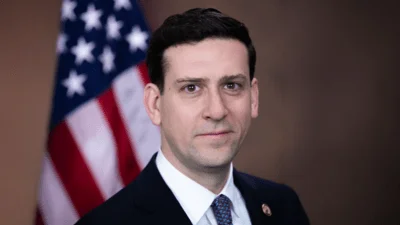Good afternoon. It’s a pleasure to speak with you about a critical topic for the future of our economy.
Many Americans have stated concerns about our nation’s ability to compete and win on the global stage.
A recent poll of U.S. businesses found worry that global production will lead to American job losses. The survey found strong concern about China.
On Sunday, The New York Times asked, "Are U.S. Innovators Losing Their Competitive Edge?" And a prominent group of scientists, business leaders and educators, tapped by the National Academy of Sciences to study America’s competitive position, came back with troubling findings. They claimed that "The scientific and technical building blocks of our economic leadership are eroding...." We need to make policy choices that strengthen our long-term competitive position. But we should start with the confidence that the United States has competitive advantages unavailable to any other economy.
There is no doubt that we are dealing with a global environment that is more competitive than anything that we’ve seen before. But it is also true that we have shown throughout our history that we can rise to any challenge.
Just think about what we’ve confronted over the past five years: These are real concerns. We take them seriously, but policy choices should not be dictated by fear. Policy should be driven by steps that build upon and sustain our strengths.
The primary challenge for policy makers is to keep our performance going. President Bush has an aggressive agenda that is focused on our long term economic challenges. And he is right to think long-term. We need to position America to compete in the global economy, not just for the next three years but for the long haul.
We have all the necessary resources and skills to not only continue to be the most competitive economy in the world, but to strengthen our position.
We have the best people. They are hardworking and unafraid to chase their dreams. We have world class infrastructure. We have the best innovation track record in the world. We have a business environment that attracts capital and promotes entrepreneurship.
Our success is due to our people. And to continue to develop the best talent in the world, our education system needs to prepare American workers for the 21st century.
American children score well against the rest of the world on math and science through fourth grade. But between then and 12th grade, their test scores drop.
President Bush has acted. The No Child Left Behind Act was put in place in 2002 and we are already achieving results. Standards are higher, national test scores are on the rise, and minority students are closing the achievement gap. On this year's tests, fourth grade reading scores were six points higher than in 2000. Fourth grade math scores were the highest in the test's history.
The President recognizes we have much more to do: We need to extend these high standards and accountability to our high schools. We need to develop more rigorous math and science courses and strengthen our job training system. Eighty percent of the fastest growing occupations require post high school training.
As we produce more high-tech, high-value jobs, community colleges will play a growing role in preparing our workers. Community colleges are helping millions of Americans improve their employability by gaining enhanced skills. The President increased funding to allow community colleges to double the number of workers they train for jobs in growing industries.
Last year, China graduated over 600,000 engineers, India 350,000, and America 70,000.
The President’s budget provides $78 billion in financial assistance—a 55 percent increase since 2001. This means 2 million more students will attend college.
American universities have the best MBA programs in the world. Our business schools are producing graduates that help our companies compete. Management is a competitive advantage.
A recent study by the London School of Economics confirms this point. Researchers found that US companies operate with significantly higher productivity, which they attributed to uniquely American styles of management and organization.
Compared to the rest of the world, U.S. businesses have, on average, a far more advanced capability in logistics, marketing, product development, and other business disciplines.
The best global companies are American. Ten of the 20 biggest companies are American. Few people could name a single Chinese global company.
Consumers all over the world are growing up with American brands such as Coke, Pepsi, and Wrigley. They are flying in Boeings, driving Fords, booting up Dells, and shopping at Wal-Mart. Our ability to do business in countries around the world is unparalleled.
Another great advantage we have is our tradition of immigration and assimilation. Immigration brings new ideas, new innovations, and new energy into our economy.
Europe’s population isn’t growing. China and Japan, for example, have no tradition of assimilating immigrants into their cultures and also have long-term demographic issues.
We are one of the only developed economies whose population will grow well into the 21st Century—if we can solve our current immigration challenges.
The Administration’s temporary worker permit program recognizes that there are jobs that need to be filled and that Americans don’t want. President Bush knows that the way we deal with our immigration today and, importantly, our attitude toward immigration, will both impact our economy for decades to come.
To allow people to perform at their full potential, we need to also address the cost of health care.
While we have the highest quality of health care in the world, increasing costs hurt both families and businesses. For example, the cost of employer-provided health care has more than doubled over the last 16 years. Health care now represents 17 percent of all consumer expenditures; the largest category.
The health care market is the only market in the USA in which sellers decide what buyers will buy, and the buyers aren’t really sure how much they are paying.
We need market based reforms. The Administration has several proposals to confront high costs with reforms driven by market forces, such as: Ninety-five percent of our trade moves through our ports. We will need to double our port capacity by 2020. It won’t happen overnight, but by planning for the long term we can ensure that we continue to have the most effective and efficient port system in the world.
When thinking about our long-term infrastructure needs, energy is critical. Congress passed the President’s energy bill this summer—the first such measure in 30 years. It encourages conservation, develops alternative energy sources, and builds energy-efficiency.
President Bush has always understood the need for long-term planning. When he introduced his energy plan, oil was roughly $30 a barrel—and critics said his plan was too long-term focused. Now, oil has reached $70 a barrel and we can only wonder how much stronger our competitive position would be, if this legislation hadn’t been stalled in Congress for five years.
Although oil prices dropped 5 percent last week and now are at their lowest level since July, we shouldn’t be surprised that our energy supply remains vulnerable to disruptions.
We have built no new refineries since 1976. Key resources like ANWR and coastal oil fields remain off-limits, even though resources can now be safely extracted.
In 1995, the White House vetoed exploration in ANWR. Had this not happened, we would have been far better positioned to withstand supply disruptions, like the impact from Hurricane Katrina.
When oil prices are low, we take it for granted and we become complacent. When prices are high, we want immediate corrections. This invariably leads to reactive decisions that usually backfire. We need to get to work on the President’s plan.
The Highway Bill the President signed will invest $286 billion to upgrade our nation’s networks of roads, bridges and mass transit systems to make the delivery of goods and services faster and more efficient.
An efficient communications network is another vital requirement for growth. President Bush has called for universal, affordable broadband access by 2007—and the number of broadband lines has grown 250 percent since President Bush took office.
In June 2001 there were 9.6 million broadband lines, and in December 2004 there were 37.9 million lines.
Broadband will build on an area of strength. U.S. Internet commerce is already three times that of Japan, our closest competitor.
Most of the great innovations during our time have all come from America: aviation, telecommunications, the computer, and countless advances in health care.
Federal research and development funding has given us path-breaking new technologies. And President Bush continues strong R&D investment. This year’s R&D budget is 45 percent larger than 2001.
This is the highest discretionary R&D spending in 37 years. Not since the Apollo space program have we seen a greater concentration on innovation funding.
A third of our GDP is based on products that need IPR protection. Ours is an increasingly knowledge-based economy. A recent study shows that 75 percent of the value of publicly traded U.S. companies—some $5 trillion—comes from "intangible" assets such as brands, copyrights, and patents.
We can’t allow the creation of a world environment where patents and trademarks and copyrights don’t mean anything.
Providing a secure environment for innovation is a key focus for the Administration. IPR protection for U.S. brands and innovative technologies has never been more important—going forward, it will only be more so. We can continue to create the environment in which innovation flourishes.
We have the best business environment and we attract more capital than any country in the world and we can still make it better.
On the domestic front, a growth climate begins with sound fiscal and monetary policies.
President Bush’s tax relief gave Americans new reasons to save and invest. There’s no question that the tax cuts spurred our economic growth. But President Bush knew that we had to cut taxes on capital gains and dividends to keep growing.
The President’s tax relief lowered the cost of capital. This helped companies expand, upgrade, and create new jobs.
Some say the tax cuts were only for the rich. Yet, after the President’s tax cuts, higher-income taxpayers pay a greater share; and the share paid by the bottom half of taxpayers falls to 3.6 percent.
Critics claimed that we couldn’t "afford" tax relief. And the federal government is taking in more tax dollars than before the tax cuts because our economy is growing faster. Our deficit was about a hundred billion dollars lower than last year.
Most of the world’s growing economies have relatively low tax rates. Raising taxes on business will kill jobs and weaken our economy. We believe that in a global economy where everyone is competing for capital, taxes must be low. High tax rates are a global competitive disadvantage.
Legal reform is another critical area to our business environment.
We know that the current tort system is costing America $240 billion each year. That’s more than the country spends on R&D. So, we spend more money suing each other than we do innovating and creating jobs.
Tort costs in America are now far higher than in any other major industrialized nation.
Congress passed, and the President signed, class-action lawsuit reform this year. The President has called for Congress to act on asbestos litigation reform, and medical malpractice reform.
Trade is a topic where our long-term competitive position is at the greatest risk from self-defeating policy prescriptions—like protectionism.
In the United States, we look outward with a vision of economic engagement. We have always been a country of explorers. We have always been a country of travelers. We have always been a country of business pioneers. And we should continue reaching out to people around the world to do business.
Economic activity related to trade now accounts for almost a third of our GDP. And about 12 million Americans depend on exported goods and services for their jobs.
President Bush has built on this legacy by negotiating free trade agreements with 12 different countries from Australia to Chile—more free trade agreements than all previous administrations combined. In the first quarter of this year, U.S. exports to Australia were up almost 12 percent. Last year, our exports to Chile grew by a third.
The North American Free Trade Agreement is another powerful example. Between the point NAFTA passed in 1993 and last year, NAFTA countries have grown: President Bush has challenged the world to eliminate tariffs and barriers as a way to grow and lift millions of people out of poverty. President Bush knows that trade and open markets, not protectionism, is the way of the future.
In closing, I want to make a final comment about the media mindset in America today. If you follow popular coverage, you would think that America has peaked.
By this reasoning, China, India, and others are raising the heat so high in the global economy that America will be forced to flee. We reject the idea that America can’t compete; we have all seen Americans compete and win in markets across the world.
All of you can influence this debate. The Wilson Center bridges the gap between the arena of ideas and the world of policy.
I encourage all of you to take part. We need to reject the defeatists who are spreading anxiety for political gain. This is not a time for hand-wringing; it is time for a relentless focus on creating our future.
America has always competed. And we have always thrived under competition. People from around the world come here to succeed.
When a New York Times survey asked, "Do you think it’s still possible to start out poor in this country, work hard, and become rich?" eighty percent said, "Yes." So, now is not the time to doubt our entrepreneurs, our markets, our companies or our workers. If we unleash the power of private enterprise, Americans will always succeed. The President’s plan does just that.
Thank you very much.
Source: U.S. Department of Commerce








